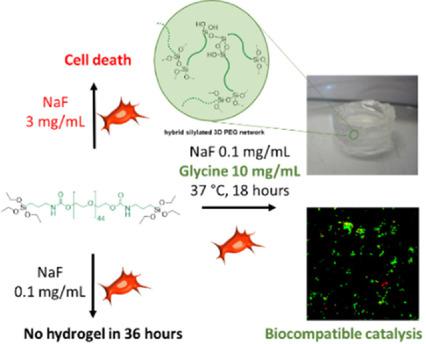当前位置:
X-MOL 学术
›
ChemPlusChem
›
论文详情
Our official English website, www.x-mol.net, welcomes your
feedback! (Note: you will need to create a separate account there.)
Biocompatible Glycine-Assisted Catalysis of the Sol-Gel Process: Development of Cell-Embedded Hydrogels.
ChemPlusChem ( IF 3.0 ) Pub Date : 2019-10-24 , DOI: 10.1002/cplu.201900509 Laurine Valot 1, 2 , Marie Maumus 3 , Titouan Montheil 1 , Jean Martinez 1 , Danièle Noël 3 , Ahmad Mehdi 2 , Gilles Subra 1
ChemPlusChem ( IF 3.0 ) Pub Date : 2019-10-24 , DOI: 10.1002/cplu.201900509 Laurine Valot 1, 2 , Marie Maumus 3 , Titouan Montheil 1 , Jean Martinez 1 , Danièle Noël 3 , Ahmad Mehdi 2 , Gilles Subra 1
Affiliation

|
The sol-gel process can be used for hydrogel cross-linking, thus opening an attractive route for the design of biocompatible hydrogels under soft conditions. The sol-gel process can be catalysed at basic or acidic pH values, under neutral conditions with the addition of a nucleophile. Therefore, working around pH 7 unlocks the possibility of direct cell embedment and the preparation of bioinks. We aimed to propose a generic method for sol-gel 3D bioprinting, and first screened different nucleophilic catalysts using bis-silylated polyethylene glycol (PEG) as a model hydrogel. A synergistic effect of glycine and NaF, used in low concentrations to avoid any toxicity, was observed. Biocompatibility of the approach was demonstrated by embedding primary mouse mesenchymal stem cells. The measure of viscosity as a function of time showed the impact of reaction parameters, such as temperature, complexity of the medium, pH and cell addition, on the kinetics of the sol-gel process, and allowed prediction of the gelation time.
中文翻译:

生物相容性甘氨酸辅助的Sol-Gel催化过程:细胞嵌入水凝胶的开发。
溶胶-凝胶工艺可用于水凝胶交联,从而为在柔软条件下设计生物相容性水凝胶开辟了一条诱人的途径。溶胶-凝胶过程可以在碱性或酸性pH值下,在中性条件下,通过添加亲核试剂进行催化。因此,在pH值7左右工作可释放直接嵌入细胞和制备生物墨水的可能性。我们旨在提出一种用于溶胶-凝胶3D生物打印的通用方法,并首先使用双甲硅烷基化的聚乙二醇(PEG)作为模型水凝胶筛选出不同的亲核催化剂。观察到甘氨酸和NaF的协同作用,低浓度使用可避免任何毒性。通过嵌入原代小鼠间充质干细胞证明了该方法的生物相容性。
更新日期:2019-10-24
中文翻译:

生物相容性甘氨酸辅助的Sol-Gel催化过程:细胞嵌入水凝胶的开发。
溶胶-凝胶工艺可用于水凝胶交联,从而为在柔软条件下设计生物相容性水凝胶开辟了一条诱人的途径。溶胶-凝胶过程可以在碱性或酸性pH值下,在中性条件下,通过添加亲核试剂进行催化。因此,在pH值7左右工作可释放直接嵌入细胞和制备生物墨水的可能性。我们旨在提出一种用于溶胶-凝胶3D生物打印的通用方法,并首先使用双甲硅烷基化的聚乙二醇(PEG)作为模型水凝胶筛选出不同的亲核催化剂。观察到甘氨酸和NaF的协同作用,低浓度使用可避免任何毒性。通过嵌入原代小鼠间充质干细胞证明了该方法的生物相容性。











































 京公网安备 11010802027423号
京公网安备 11010802027423号